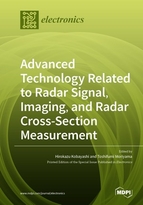Advanced Technology Related to Radar Signal, Imaging, and Radar Cross-Section Measurement
A special issue of Electronics (ISSN 2079-9292). This special issue belongs to the section "Microwave and Wireless Communications".
Deadline for manuscript submissions: closed (31 August 2019) | Viewed by 112809
Special Issue Editors
Interests: radar imaging; inverse synthetic aperture radar; electromagnetic modeling; radar cross-section theory and measurement; radar beam scanning; radar signal processing
Special Issues, Collections and Topics in MDPI journals
Interests: radar polarimetry; inverse scattering; microwave remote-sensing; wireless sensor networks
Special Issues, Collections and Topics in MDPI journals
Special Issue Information
Dear Colleagues,
A radar system is made of many elemental and hard/software technologies. Recent applications are expanding to short distance radar, such as security, nondestructive observation, and aerial monitoring, as well as long distance radar, such as remote-sensing, surveillance, and weather observation. In these various applications, the key technologies supporting radar are essentially the signal, image, and data processing in order to detect a target more explicitly, which includes synthetic aperture imaging, compressive sensing, multiple input multiple output (MIMO) processing, and radar beam scanning, in a broad sense. On the other hand, radar cross-section (RCS) evaluation and electromagnetic modeling technologies of radar targets are also important to develop future smart radar.
The aim of this Special Issue of Electronics is to present state-of-the-art investigations in various radar-important technologies for future applications. We invite researchers to contribute original and unique articles, as well as sophisticated review articles. Topics include, but not limited to, the following areas:
- radar imaging technology
- inverse synthetic aperture radar imaging
- inverse electromagnetic scattering
- short-distance radar
- collision-avoidance radar
- subsurface and ground penetrating radar
- microwave remote sensing image analysis
- RCS near-field to far-field transformation
- radar electromagnetic modeling and simulation
- target recognition
- radar data fusion
Prof. Dr. Hirokazu Kobayashi
Dr. Toshifumi Moriyama
Guest Editors
Manuscript Submission Information
Manuscripts should be submitted online at www.mdpi.com by registering and logging in to this website. Once you are registered, click here to go to the submission form. Manuscripts can be submitted until the deadline. All submissions that pass pre-check are peer-reviewed. Accepted papers will be published continuously in the journal (as soon as accepted) and will be listed together on the special issue website. Research articles, review articles as well as short communications are invited. For planned papers, a title and short abstract (about 100 words) can be sent to the Editorial Office for announcement on this website.
Submitted manuscripts should not have been published previously, nor be under consideration for publication elsewhere (except conference proceedings papers). All manuscripts are thoroughly refereed through a single-blind peer-review process. A guide for authors and other relevant information for submission of manuscripts is available on the Instructions for Authors page. Electronics is an international peer-reviewed open access semimonthly journal published by MDPI.
Please visit the Instructions for Authors page before submitting a manuscript. The Article Processing Charge (APC) for publication in this open access journal is 2400 CHF (Swiss Francs). Submitted papers should be well formatted and use good English. Authors may use MDPI's English editing service prior to publication or during author revisions.
Keywords
- radar imaging technology
- inverse synthetic aperture radar imaging
- inverse electromagnetic scattering
- short-distance radar
- collision-avoidance radar
- subsurface and ground penetrating radar
- microwave remote sensing image analysis
- RCS near-field to far-field transformation
- radar electromagnetic modeling and simulation
- target recognition
- radar data fusion







